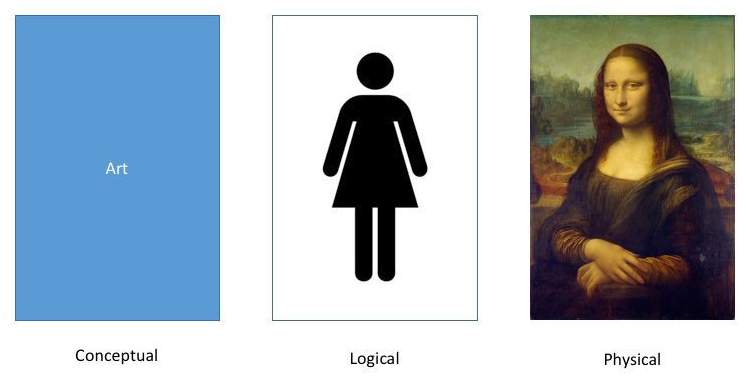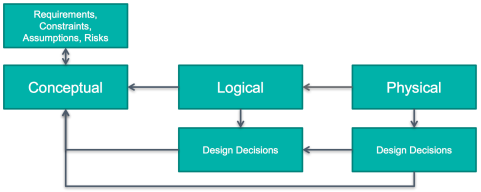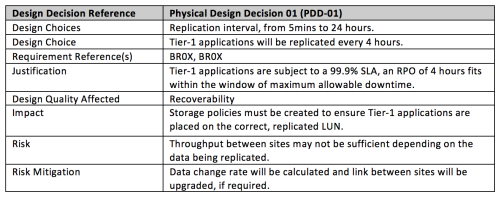This year I am honored to be one of the Virtual Design Master (vDM) judges. If you are unfamiliar with vDM, it is a technology driven reality competition that showcases virtualization community member and their talents as architects. Some competitors are seasoned architect while others are just beginning their design journey. To find out more information, please click here. One of the things that I, along with the other judges, noticed is that many of the contestants did not correctly document conceptual, logical, and physical design.
The best non-IT example that I have seen of this concept the following image:

The way I always describe and diagram design methodology is using the following image:

I will continue to refer to both images as we move forward in this post.
Conceptual
During the assess phase, the architect reaches out to the business’ key stakeholders for the project and explore what each need and want to get out of the project. The job is to identify key constraints and the business requirements that should be met for the design, deploy, and validation phases to be successful.
The assessment phase typically coincides with building the conceptual model of a design. Effectively, the conceptual model categorizes the assessment findings into requirements, constraints, assumptions, and risks categories.
For example:
Requirements –
- technicloud.com should create art.
- The art should be durable and able to withstand years of appreciation.
- Art should be able to be appreciated by millions around the world.
Constraints –
- Art cannot be a monolithic installation piece taking up an entire floor of the museum.
- Art must not be so bourgeoisie that it cannot be appreciated with an untrained eye.
- Art must not be paint-by-numbers.
Risks –
- Lead IT architect at technicloud.com has no prior experience creating art.
- Mitigation – will require art classes to be taken at local community college.
- Lead IT architect is left-handed which may lead to smearing of art.
- Mitigation – IT architect will retrain as ambidextrous.
Assumptions –
- Art classes at community college make artists.
- Museum will provide security as to ensure art appreciators do not damage artwork.
As you read through the requirements and constraints, the idea of how the design should look should be getting clearer and clearer. More risks and assumptions will be added as design decisions are made and the impact is analyzed. Notice that the conceptual model was made up entirely of words? Emphasis on “concept” in the word “conceptual”!
Logical
Once the conceptual model is built out, the architect moves into the logical design phrase (which indicated by the arrows pointing backwards in Figure 2, demonstrating dependence on conceptual). Logical design is where the architect begins making decisions but at a higher level.
Logical art work design decisions –
- Art will be a painting.
- The painting will be of a person.
- The person will be a woman.
For those who are having a hard time following with the art example, a tech example would be:

An example of what a logical diagram may look something like this:

Notice that these are ‘higher’ level decisions and diagrams. We’re not quite to filling in the details yet when working on logical design. However, note that these design decisions should map back to the conceptual model.
Physical
Once the logical design has been mapped out, architect moves to physical design where hardware and software vendors are chosen and configuration specifications are made. Simply put, this is the phase where the details are determined.
Physical art work design decisions –
- The painting will be a half-length portrait.
- The medium will be oil on a poplar panel.
- The woman will have brown hair.
Once again, if you hate the Mona Lisa then the IT design decision example would be:
- XYZ vendor and model of storage array will be purchased.
- Storage policy based management will be used to place VMs on the correct storage tier.
- Tier-1 LUNs will be replicated hourly.
These are physical design decisions, which directly correlate and extend the logical design decisions with more information. But, again, at the end of the day, this should all tie back to meeting the business requirements.

An example of a physical design would be something like:

Notice that in this diagram, we’re starting to see more details: vendor, model, how things are connected, etc. Remember that physical should expand on logical design decisions and fill in the blanks. At the end of the day, both logical and physical design decisions should map back to meeting the business requirements set forth in the conceptual model (as evidenced by Figure 2).
Final Thoughts
Being able to quickly and easily distinguish takes time and practice. I am hoping this clarifies some of the mystery and confusion surrounding this idea. Looking forward to seeing more vDM submissions next week.
Hi Rebecca,
(to carry on from my comment on twitter).
As i said in my tweet, it is a great article and explains the topic well.
I agree there is no need for the conceptual model to be a diagram, there seems to be a misconception that a “model” needs to be a picture.
I also agree with the way you have described the interactions between the conceptual, logical and physical models. In the past, I have worked with companies that term these High (covering conceptual and logical) and Low Level (Physical) models/designs (but it is all semantics).
I just personally feel Risks, Assumptions, Issues and Dependencies are not just at the conceptual level. The design decisions may track back but, i think RAID is something that happens continually during the design process. Whereas, the way in which I read your diagram suggests to me this happens up front and it’s not a continual process.
The only other comments i had were around the examples provided (and as these are in isolation maybe i’m just reading too much into it because i think I’m agreeing):
For me Risks need to have a business impact but you seem to be describing what i would term the “fall back” option. You seem to answering the question “What do i do technically when my risk becomes a reality because the mitigation didn’t work?” and, to me, that’s not an Impact to the business. Which is ultimately what matters.
Finally, whilst only an example (and it could just be wording), i don’t necessary agree with the assumption:
Art classes at community college make artists.
Even at a conceptual level, can a college, MAKE an artist? Maybe a better assumption would be
“the college runs art classes” or “the art created will be of sufficient quality to be placed into a museum.”
As i said in my tweet, just because i don’t agree with something doesn’t make it wrong. I’m not THAT narcissistic.
Chris
LikeLiked by 1 person
Chris,
First off, thank you for your comments and keeping the dialogue open. I always enjoy talking with other architects and hearing about their methodology.
I understand how the diagram may not be clear. It’s simply meant to show that every ties back to conceptual and that everything else builds upon that foundation.
I agree with you wholeheartedly regarding Risks, Assumptions, Issues, and Dependencies not just happening at the conceptual level. While initial risks and assumptions may be made during the assess phase, the bulk is gathered further along in the design process. I had a line that read “More risks and assumptions will be added as design decisions are made and the impact is analyzed.” Perhaps I need to bold or italicize that statement to really call it out.
I wholehearted accept that the examples are not perfect (wrote this article late in the evening after vDM concluded). I see your point regarding “Art classes at a community college make artists.” However, I would still classify this as an assumption because it is unknown variable. Can any college make an artist? I don’t know, mark it as an assumption that it can (or cannot), and go back later and validate whether it can or not. I very much like your examples, too bad I didn’t think of those late last night when I was writing the article. 🙂
Regarding risk, I agree with you. I think the examples given would result in a business impact. For example, no art experience or my being left handed and smearing the paint could lead to subpar results which impact the business goal of creating artwork to be hung in a museum. For the technical examples, I may assume that the link between sites has sufficient bandwidth but, if un-validated, the risk is that replication may be unsuccessful or latent due to insufficient throughput which would lead to a missed RPO and ultimately being unable to meet the defined SLA.
Unfortunately, in reality, some risk cannot be mitigated. Or if every risk were to be mitigated then that would result in high costs and/or gratuitous reconfiguration.
My goal was to briefly describe conceptual, logical, physical with examples in less than 1000 words so it would be readable. Perhaps a more lengthy explanation would have been helpful.
-Rebecca
LikeLiked by 1 person
[…] I wrote a post about design methodology, specifically about conceptual, logical, physical. […]
LikeLike
Hi Rebecca,
I was looking a breakout on the concepts of conceptual, logical and physical and this is really helpful. I’m wondering if you can recommend some references that address industry standards that would expand on this. For example have you read any good Zachman Framework books that you recommend?
Thanks!
Ryan
LikeLiked by 2 people
Ryan, thanks for the message. I found the books “Enterprise Architecture Using the Zachman Framework” and “Enterprise Architecture As Strategy: Creating a Foundation for Business Execution” to be especially helpful. As well as this PDF: https://communities.vmware.com/docs/DOC-17408
Hope this helps you get started!
-Rebecca
LikeLike
Ordered them – much appreciated. Please keep up the insightful and valuable contributions to the community!
LikeLike
[…] I tend to work through any design by walking through the conceptual model, logical design, and then physical. If you are unfamiliar with these concepts, please take a look at this post. […]
LikeLike
[…] have previously written about putting together the conceptual model with logical and physical design; however, I want to […]
LikeLike
[…] https://technicloud.com/2017/07/07/virtual-design-master-conceptual-logical-physical/ https://technicloud.com/2018/08/07/visualizing-the-conceptual-model-for-it-architecture/ https://communities.vmware.com/thread/476552 http://www.brcommunity.com/articles.php?id=b043a https://vcdx133.com/2015/05/06/vcdx-great-logical-design/ […]
LikeLike
[…] Virtual Design Master: Conceptual, Logical, Physical: https://technicloud.com/2017/07/07/virtual-design-master-conceptual-logical-physical/ […]
LikeLike
[…] Virtual Design Master: Conceptual, Logical, Physical […]
LikeLike
[…] Understand the basics of design – Conceptual, Logical, Physical. A great explanation of the differences is outlined in Rebecca Fitzhugh’s blog […]
LikeLike
[…] Virtual Design Master: Conceptual, Logical, Physical […]
LikeLike